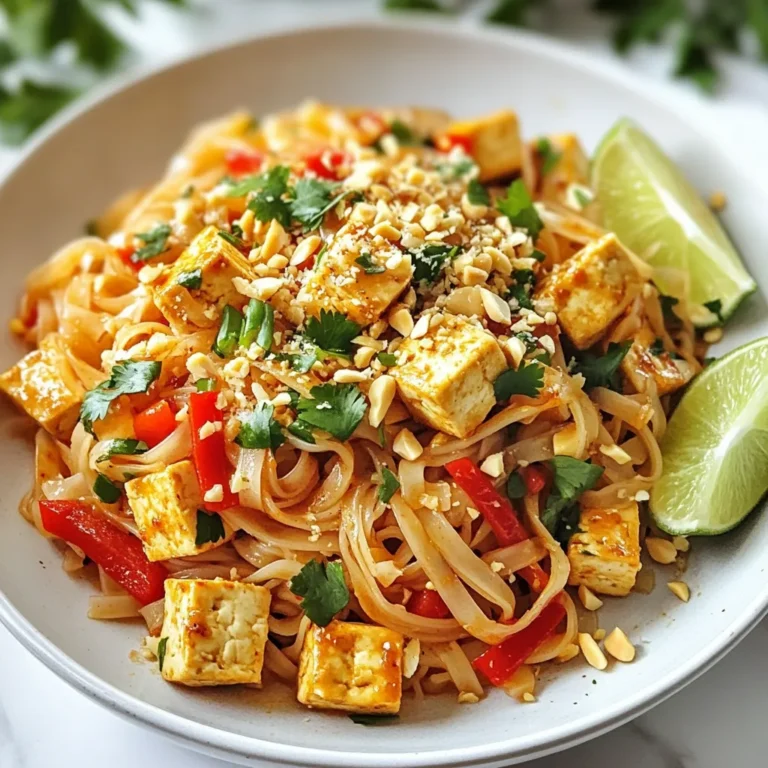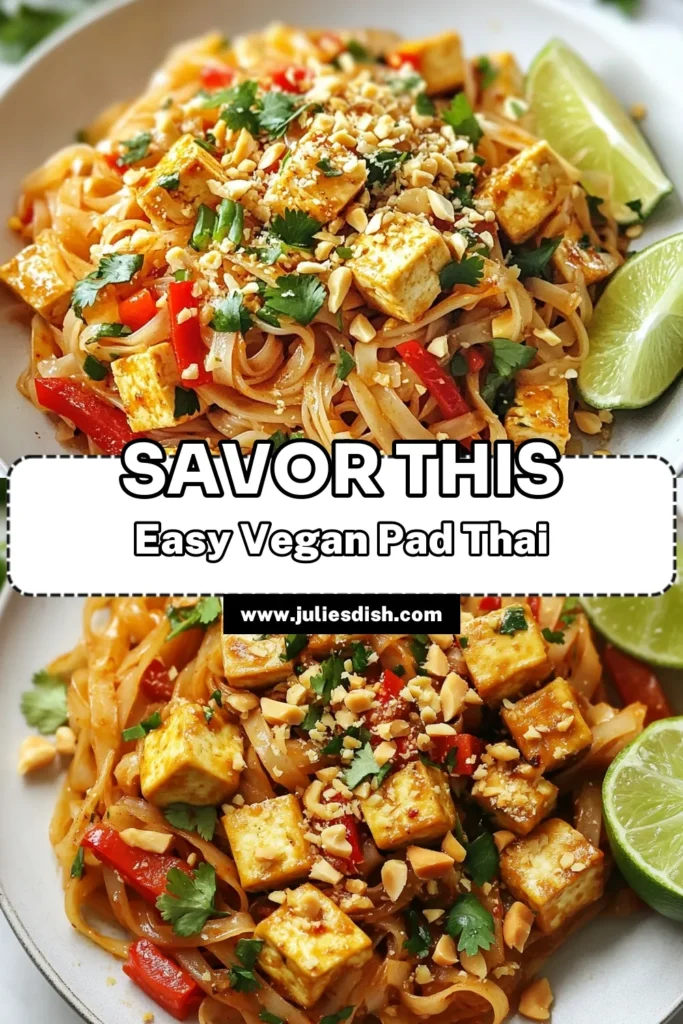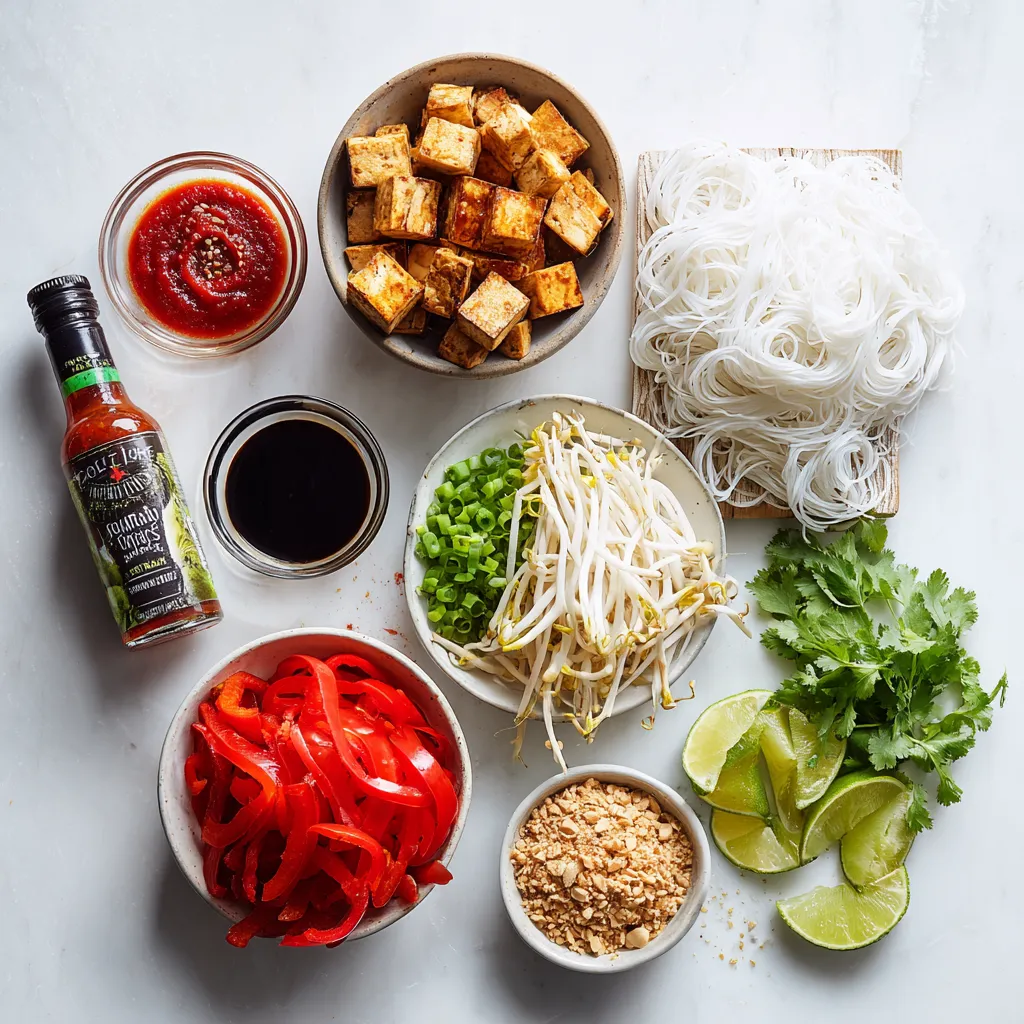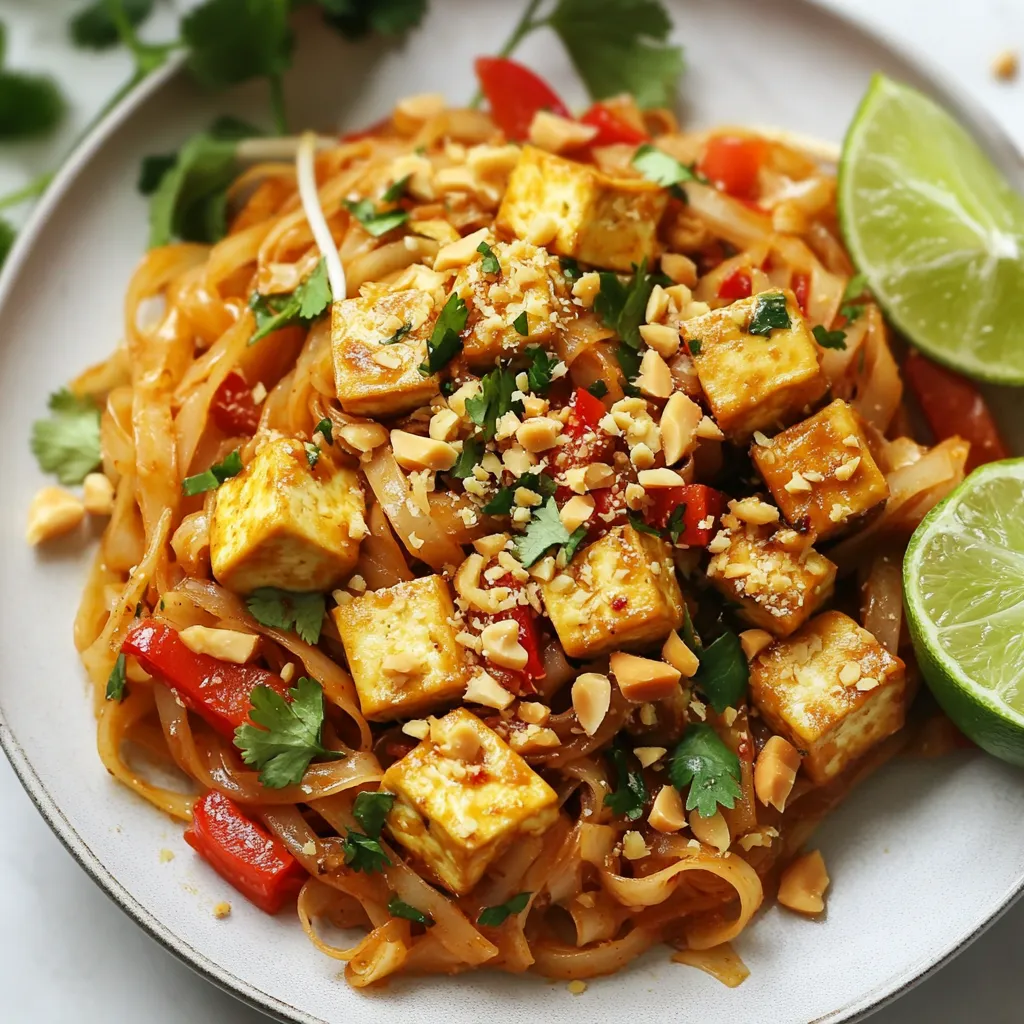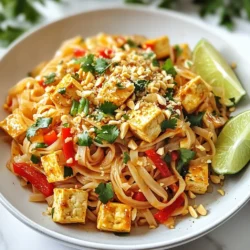WANT TO SAVE THIS RECIPE?
Looking for a quick and tasty dinner? This Easy Vegan Pad Thai recipe is your answer. Packed with fresh veggies, firm tofu, and rich flavors, it’s ready in just 30 minutes. I’ll show you how to whip up this classic dish with simple ingredients and tasty sauces. Perfect for busy weeknights, this recipe is sure to please everyone at your table. Let’s dive into making your new favorite meal!
Why I Love This Recipe
- Quick and Easy: This Vegan Pad Thai can be prepared in just 25 minutes, making it a perfect weeknight dinner option.
- Flavorful Ingredients: The combination of tamari, maple syrup, and sriracha creates a deliciously balanced sauce that enhances every bite.
- Nutritious and Wholesome: Packed with vegetables and protein-rich tofu, this dish is both satisfying and healthy.
- Customizable: You can easily modify this recipe by adding your favorite vegetables or adjusting the spice level to your liking.
Ingredients
Main ingredients for Easy Vegan Pad Thai
– 8 oz rice noodles
– 1 cup firm tofu, cubed
– 1 red bell pepper, thinly sliced
– 1 cup bean sprouts
– 3 green onions, chopped
– 2 cloves garlic, minced
Rice noodles make the base of the dish. They are soft and chewy. You can find them in most grocery stores. Firm tofu adds protein and texture. It soaks up flavor well, making each bite tasty. Fresh vegetables, like red bell pepper and bean sprouts, provide crunch and color.
Seasonings and sauces
– 2 tablespoons tamari or soy sauce
– 1 tablespoon maple syrup
– 1 teaspoon sriracha (or to taste)
Tamari or soy sauce gives saltiness and depth. Maple syrup adds a touch of sweetness. You can adjust the sriracha for spice. This blend creates the classic Pad Thai flavor.
Garnishing options
– 1/4 cup crushed peanuts
– Fresh cilantro
– Lime wedges
Crushed peanuts add crunch and a nutty taste. Fresh cilantro brightens up the dish with its herbal notes. Lime wedges bring a zesty kick when squeezed on top. These garnishes make your meal pop with flavor and color.

Step-by-Step Instructions
Cooking the noodles
To cook the rice noodles, start by boiling water in a large pot. Add 8 ounces of rice noodles. Cook them according to the package instructions, which usually takes about 4 to 6 minutes. Once done, drain the noodles and rinse them under cold water. This step stops them from sticking together. Set the noodles aside while you prepare the other ingredients.
Sautéing the tofu
For crispy tofu, use firm tofu. First, cube 1 cup of tofu. Heat 1 tablespoon of coconut oil in a large skillet over medium heat. Add the cubed tofu to the hot oil. Sauté the tofu for about 5 to 7 minutes. Turn the pieces to get them golden and crispy on all sides. Once crispy, remove the tofu from the skillet and set it aside.
Cooking the vegetables
In the same skillet, add 1 tablespoon of coconut oil. Once the oil is hot, add 2 cloves of minced garlic. Sauté the garlic for about 30 seconds until it smells nice. Next, add 1 thinly sliced red bell pepper. Cook the pepper for 2 to 3 minutes until it softens, but still stays crisp.
Combining all ingredients
Now, it’s time to mix everything. Add the cooked rice noodles and crispy tofu back into the skillet. Pour in 2 tablespoons of tamari or soy sauce, 1 tablespoon of maple syrup, 1 tablespoon of lime juice, and some sriracha to taste. Stir everything together gently. Aim to coat the noodles and tofu evenly with the sauce for about 2 to 3 minutes.
Adding final touches
To finish, toss in 1 cup of bean sprouts and 3 chopped green onions. Stir gently to mix them in. Cook for an extra minute until the bean sprouts are warm but still crunchy.
Serving suggestions
Remove the skillet from heat and transfer your Vegan Pad Thai to serving plates. For a nice touch, garnish with 1/4 cup of crushed peanuts and fresh cilantro. Serve with lime wedges on the side for an extra burst of flavor! Enjoy your meal!
Tips & Tricks
How to customize your Vegan Pad Thai
You can make your Vegan Pad Thai your own. Start by adding more vegetables. Consider carrots, snap peas, or broccoli. These add color and nutrients. You can also adjust spice levels. If you like heat, add more sriracha. For a milder version, use less.
Common substitutions
Some may want to switch out ingredients. If you don’t like tofu, try chickpeas or tempeh. They offer great protein. You can also change the noodle options. Rice noodles work well, but zucchini noodles are low-carb. You can even use whole wheat noodles for added fiber.
Making it gluten-free
To make your Vegan Pad Thai gluten-free, change a few ingredients. Use gluten-free tamari instead of soy sauce. Check the noodle package for gluten-free options. Many rice noodles are gluten-free. This way, you can enjoy a tasty meal without worry.
Pro Tips
- Perfectly Cooked Noodles: Make sure to rinse the noodles under cold water after cooking to stop the cooking process and prevent them from becoming mushy.
- Tofu Texture: For extra crispy tofu, press it for at least 15 minutes to remove excess moisture before cubing and cooking.
- Customize Your Heat: Adjust the amount of sriracha according to your spice preference; start with a small amount and add more if desired.
- Add Freshness: For an extra burst of flavor, add a squeeze of lime juice just before serving to brighten up the dish.

Variations
Different protein options
You can change the protein in your Vegan Pad Thai. Chickpeas make a great choice. They add a nice texture and flavor. Tempeh is another option. It has a firm texture that soaks up sauces well. Seitan is also tasty. It has a chewy texture similar to meat. Pick one or mix them for a fun twist.
Vegan Pad Thai with peanut sauce
For a creamy peanut sauce, combine peanut butter, tamari, and lime juice. You can also add a bit of maple syrup for sweetness. This sauce will make the dish rich and flavorful. Toss it with your noodles, tofu, and veggies for a delightful meal. Drizzle extra sauce on top for a bold taste.
Low-carb alternatives
If you want a low-carb meal, try using zucchini noodles. They are fresh and crunchy. You can spiralize zucchini to create thin noodles. Cauliflower rice is another great choice. It adds volume and is very filling. Both options keep the dish light while still being delicious.
Storage Info
Storing leftovers
To store your Vegan Pad Thai, use airtight containers. Glass or BPA-free plastic works best. Let the dish cool to room temperature before sealing. Store it in the fridge for up to three days. If you want to keep it longer, consider freezing it.
Reheating instructions
For reheating, the safest method is using the stove. Place the Vegan Pad Thai in a skillet over low heat. Add a splash of water or oil to prevent sticking. Stir often until heated through. You can also use a microwave. Place the dish in a microwave-safe bowl, cover it, and heat in short bursts of 30 seconds. Stir between each burst.
Freezing options
To freeze Vegan Pad Thai, first let it cool completely. Then, portion it into freezer-safe bags or containers. Remove as much air as possible before sealing. It can last in the freezer for about two months. To thaw, transfer it to the fridge overnight. Reheat as described above.
FAQs
Can I make Vegan Pad Thai ahead of time?
Yes, you can prepare Vegan Pad Thai ahead of time. To do this, cook the noodles and tofu first. Store each ingredient in separate containers. Keep the sauce in a jar. This way, the noodles won’t stick together. When you are ready to eat, just combine everything in a pan to heat it up. This saves time on busy days.
How long does Vegan Pad Thai last in the fridge?
Vegan Pad Thai lasts about 3 to 4 days in the fridge. Make sure to store it in an airtight container. Check for any signs of spoilage, like a sour smell or mold. If you see these signs, it is best to throw it away. Fresh ingredients like bean sprouts may wilt faster, so use those first.
Is this recipe nut-free?
Yes, this recipe can be nut-free. Just skip the crushed peanuts on top. You can use seeds like sunflower seeds or pumpkin seeds as a crunchy topping. This keeps the dish safe for those with nut allergies.
Can I use other sauces instead of tamari?
Absolutely! If you want to change the flavor, you can use soy sauce. Other great options include coconut aminos or liquid aminos. Each sauce adds a different taste. Experiment to find your favorite!
This Easy Vegan Pad Thai brings together rice noodles, firm tofu, and fresh veggies for a tasty dish. You can customize it with sauces like tamari and maple syrup. Remember to sauté the tofu for the best crunch. This recipe allows for different proteins and is easy to make gluten-free.
In the end, you have a delicious vegan meal that is fun to make and share. Enjoy your cooking journey and make it your ow
Vegan Pad Thai Paradise
A delicious and healthy vegan twist on traditional Pad Thai, featuring rice noodles, tofu, and fresh vegetables.
Prep Time 10 minutes mins
Cook Time 15 minutes mins
Total Time 25 minutes mins
Course Main Course
Cuisine Thai
Servings 2
Calories 350 kcal
- 8 oz rice noodles
- 2 tablespoons coconut oil
- 1 cup firm tofu, cubed
- 1 piece red bell pepper, thinly sliced
- 1 cup bean sprouts
- 3 pieces green onions, chopped
- 2 cloves garlic, minced
- 2 tablespoons tamari or soy sauce
- 1 tablespoon maple syrup
- 1 tablespoon lime juice
- 1 teaspoon sriracha
- 0.25 cup crushed peanuts (for garnish)
- none Fresh cilantro (for garnish)
- none Lime wedges (for serving)
Bring a large pot of water to a boil. Add the rice noodles and cook according to package instructions, usually around 4-6 minutes. Drain and rinse under cold water to prevent sticking. Set aside.
In a large skillet or wok, heat 1 tablespoon of coconut oil over medium heat. Add the cubed tofu and sauté until golden and crispy on all sides, about 5-7 minutes. Remove tofu from the skillet and set aside.
In the same skillet, add the remaining tablespoon of coconut oil. Add the minced garlic and sauté for about 30 seconds until fragrant. Then add the sliced red bell pepper and continue to sauté for another 2-3 minutes until softened.
Add the cooked rice noodles and the sautéed tofu back into the skillet. Pour in the tamari or soy sauce, maple syrup, lime juice, and sriracha. Stir everything together gently, ensuring the noodles and tofu are well coated in the sauce, for about 2-3 minutes.
Toss in the bean sprouts and chopped green onions, stirring gently to combine. Cook for an additional minute until the bean sprouts are warmed but still crisp.
Remove from heat and transfer the Vegan Pad Thai to serving plates. Garnish with crushed peanuts and fresh cilantro. Serve with lime wedges on the side for extra zing!
Adjust sriracha to taste for desired spiciness.
Keyword healthy, noodles, pad thai, tofu, vegan
WANT TO SAVE THIS RECIPE?
